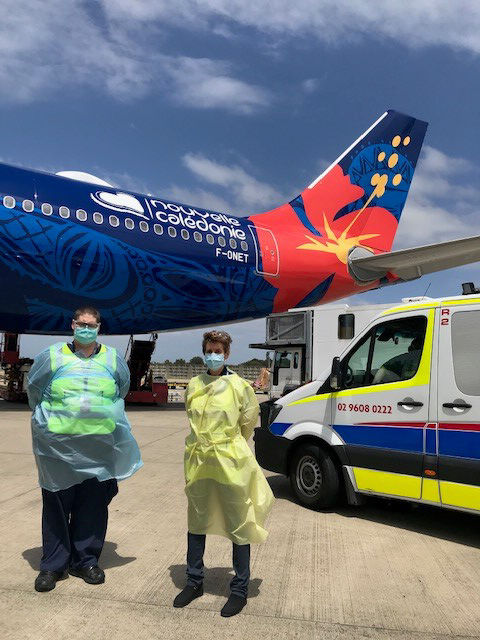Marking one year screening overseas arrivals
The dedicated SESLHD staff who screen all overseas passenger and crew arrivals – to help contain the global spread of COVID-19 – will mark one year of performing this essential work at Sydney International Airport next week.
The 200-odd SESLHD nurses and doctors who have been filling the screening staff rosters since 2 February last year, have to date screened over 230,000 people, many of whom are finally coming home after more than one year overseas.
Liz Ryan, Acting Clinical Nurse Consultant, Sydney Airport Health Screening, has been leading teams – which typically comprise a team leader, a doctor, five nurses and a translator – since day one.
The teams follow stringent processes: Only one plane is offloaded into the terminal at a time and there is no contact between passengers or crew from different flights.
“We clear everyone and complete a thorough wipe-down of all touch points before the next flight comes in,” Ms Ryan said.
While the teams were screening about 800 people per day, reduced arrivals have seen numbers reduce slightly to around 680 including crews. However, the difficult stories and complexity for arriving passengers is increasing.
“Nobody is travelling for good reasons. Everyone coming back is pretty emotional. They’re often coming home because someone’s dying, they’ve spent all their money on the airfare, they’ve lost their job or they’ve just spent months trying to get home to family,” Ms Ryan said.
“We’ve had people in the queue check their phone and find out it’s too late – their family member has died. We’ve had a lot of tragic circumstances where our staff have had to go the extra mile.”
Tony Templeton was a newly graduated nurse working at Sydney/Sydney Eye Hospital before joining the airport teams: “I thank the flight crews for bringing the Australians home safely because if it weren’t for them, there would be a lot more of us stranded overseas.”
Sharon Hunt, a registered nurse and team leader, worked in intensive care and student education before moving full-time to the airport.
“It’s almost like a social work role – we’re their first point of contact. They’re very overwhelmed. Even when you're just taking their temperature, sometimes they start crying and say ‘I can’t believe I’m on home ground’,” Ms Hunt said.
“I was around when all the COVID-positive backpackers came through, so it helped me teach the students about public health issues and how we’re dealing with it.
“Even with the vaccine coming, I think we’re going to be here protecting the population by screening arrivals for many months to come.”
Joy Gou is a freelance interpreter who was happy to take on long-term work at the airport – an opportunity rejected by many of her peers. “People with children at home or elderly parents are more reluctant,” Ms Gou said.
Jasmine Kollin, a registered nurse previously at Prince of Wales Hospital, said team members must follow the rules but remain compassionate: “Every flight has their own story – there’s so many emotions here. Often people want to be exempt from quarantine but they can’t. You can’t become desensitised to it – you have to just be human enough to really listen and hear their story. I think if it was my family, how would I be feeling?”
Jo Karnaghan, Director, Clinical Governance and Medical Services, SESLHD, said the airport screening teams were supporting a strong, cooperative working relationship with Sydney Airport Corporation and NSW Health’s other agency partners at the airport: Biosecurity, NSW Police and Border Force.
“The work can be very challenging for the teams who regularly go above and beyond. I want to thank them all – some of whom have been there since day one – for this essential work which they are performing so effectively and so kindly each day.”
